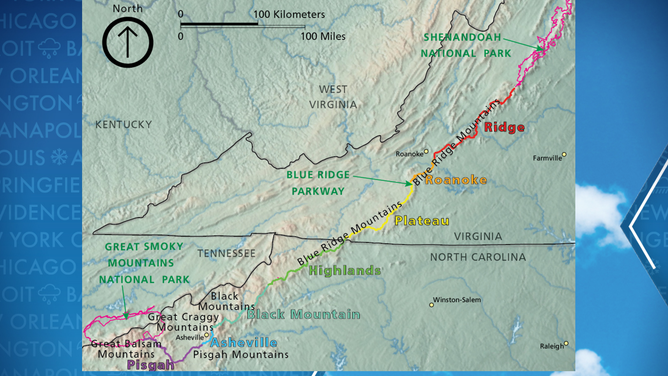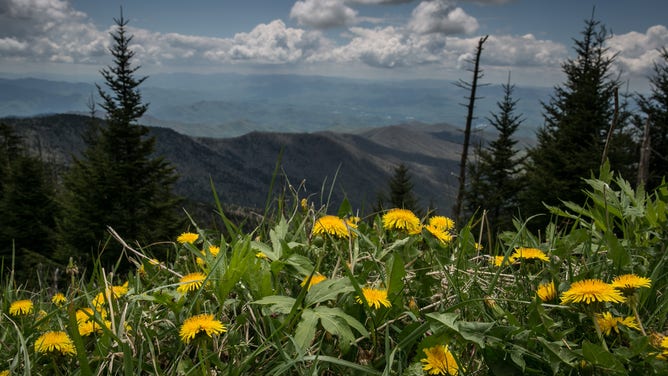The most popular national park sites visited during the spring
Nation Parks such as Yellowstone and Rocky Mountain start to become more popular during the summer, when the threat of brutally cold air is over. The National Park System covers 424 across the country.
These were the most visited national parks and memorials of 2022
Of the more than 400 locations across the country, these were the most visited national park sites in 2022 as reported by the National Park Service.
As spring break season gets underway, more than 400 national park sites around the country will welcome millions of visitors with plenty of hiking, wildlife and scenic drives.
The springtime period coincides with when temperatures start to increase significantly, and many plants and animals awaken from their winter slumber.
According to National Park Service visitation data, the Golden Gate National Recreation Area is the busiest site during meteorological spring, with locations in D.C. and the Appalachian Mountains rounding out the top five.
None of the most popular parks are on the list that see the most extreme weather, meaning many days are usually dry with comfortable temperatures.
THESE ARE THE DAYS NATIONAL PARKS WILL HAVE FREE ADMISSION IN 2023
Golden Gate National Recreation Area – California
The most popular national park location, with more than 17 million visitors a year, is the Golden Gate National Recreation Area.
The more than 82,000-acre site consists of the famous Alcatraz and the Muir Woods National Monument.
Rangers say the location is home to 19 distinct ecosystems with over 2,000 species of plants and animals.
An average April day has a temperature that starts out in the 40s and a high that reaches the 60s, which is similar to many other popular sites around the country.

UNITED STATES - JUNE 06: The Golden Gate National Recreation Area, San Francisco, California
(Photo by Carol M. Highsmith/Buyenlarge/Getty Images / Getty Images)
A Mediterranean climate tends to lead summers to be dry while winters are cool and rainy. The contrast between the usually warmer land and cool oceans helps set the stage for sea fog which is common during the late spring and summer.
Weather extremes are hard to come by in this region of California, but earthquakes are a different story.
Thousands of quakes occur every year under the Golden State, but the probability of a magnitude 6.7 or greater in the Bay Area over the next 30 years is a whopping 72 percent, according to the U.S. Geological Survey.
7 WEATHER EXTREMES EXPERIENCED AT NATIONAL PARKS
Blue Ridge Parkway – North Carolina
A parkway that straddles the rugged mountains of the Appalachians is one of the most visited National Park sites, year after year, according to visitation data from the U.S. National Park Service.
The Blue Ridge Parkway runs more than 400 miles through Virginia and North Carolina and links the Shenandoah National Park to the Great Smoky Mountains National Park.
According to rangers, the most variable time for weather is during the early spring when sunny skies can turn into snow flurries in only hours.
The parkway consists of some of the highest mountain elevations in the eastern U.S., with Mount Pisgah reaching 5,721 feet and nearby Mount Mitchell peaking at 6,684 feet.
According to the park service, temperatures can vary 10-20 degrees from the foothills to the upper regions of the mountains.
The largest city along the parkway, Asheville, North Carolina, typically sees morning lows in the 40s and highs in the 60s on a spring day.
FIRST GRIZZLY BEAR OF 2023 SPOTTED WAKING FROM HIBERNATION IN GRAND TETON NATIONAL PARK

Blue Ridge Parkway Map
(FOX Weather)
Great Smokey Mountains National Park – Tennessee
Making up more than half a million acres along the Tennessee-North Carolina line is the Great Smokey Mountains National Park.
The site is not too far away from the Blue Ridge Parkway and is comprised of some of the same mountain ranges.
According to NPS visitor data, some 3.1 million people made a stop at the park during spring 2022, making it one of America’s busiest parks.
Similar to other mountain locations, the weather can be unpredictable, but as the calendar heads from March into April, the chances for snow greatly decrease.
According to rangers, March’s highs in the 60s turn into 70-degree readings by mid-April.
With the increase in temperatures, there is sometimes a threat of afternoon showers, which helps keeps the park biologically diverse.
Scientists have identified 19,000 species of plants and animals in the park and believe there are thousands of others that have not been identified.
THE HISTORY OF GEORGIA WASHINGTON’S WEATHERVANE

A patch of dandelions near the Clingmans Dome overlook tower, a major scenic viewing point along the Appalachian Trail, is viewed on May 11, 2018 near Cherokee, North Carolina.
(George Rose / Getty Images)
Lincoln Memorial – Washington, D.C.
The nation’s capital is home to several popular park sites during the spring. It is during this season that temperatures usually start out in the 40s and reach the 60s.
It this type of weather that not only draws visitors but also leads to the annual blooming of the cherry trees.
The NPS estimated there are some 3,800 cherry trees around the Tidal Basin, and the Lincoln Memorial sits not far away.
The site was dedicated in 1922 and is the most visited site on the National Mall.
More than 2.4 million people visited the site last year during the spring months.
The memorial is free, as are all the other monuments on the mall.
HOW DC’S CHERRY BLOSSOMS ARE A LIVING VALENTINE FROM JAPAN
George Washington Memorial Parkway - Washington, D.C.
Across the Potomac River from the Lincoln Memorial sits the George Washington Memorial Parkway.
The 25-mile roadway runs from McLean, Virginia, through the western part of the District of Columbia to Mount Vernon, the home of George Washington.
Popular sites include the Robert E. Lee Memorial, Clara Barton National Historic Site and the U.S. Marine Corps Memorial.
The three months that make up meteorological spring account for nearly 30 percent of the total traffic to the sprawling site.

ARLINGTON, VA - APRIL 11: United States Marine Corps War Memorial - Iwo Jima statue outside Arlington National Cemetery on April 11, 2015 in Arlington, Virginia.
(Raymond Boyd/Getty Images / Getty Images)
The parkway’s 4,580 acres are home to at least 81 plants and animals considered rare, threatened, or endangered.
The region’s long-term average for seeing the last freeze is April 1, but on rare occasions, the mercury has dropped to 32 degrees or below through the end of April.
July is typically the warmest and wettest month in the district, which is home to more than 750 historic landmarks.
Temperatures during the spring in D.C. may be cooler than what Americans prefer.
A YouGov research poll found that the ideal average temperature for 72 degrees Fahrenheit, with only 18 percent of respondents believing that temperatures in the 60s are ideal.
